Australian Copper Market: Demand, Supply, and Price Analysis
VerifiedAdded on 2020/04/13
|7
|1484
|79
Report
AI Summary
This economics report analyzes the demand and supply dynamics of copper in the Australian market. The study explores the impact of increasing demand from electric vehicles (EVs) and the renewable energy sector on copper prices, referencing market data and economic principles. It examines how the rising demand for copper, driven by the growing popularity of EVs and the expansion of renewable energy infrastructure, affects the commodity's price, benefiting copper miners and investors. The report uses supply and demand diagrams to illustrate market shifts and discusses the inelastic price elasticity of copper. It further recommends strategies like discovering new copper resources and implementing price ceiling policies to stabilize the market and control potential price surges, ensuring a balance between supply and demand to mitigate shortages and maintain market equilibrium.
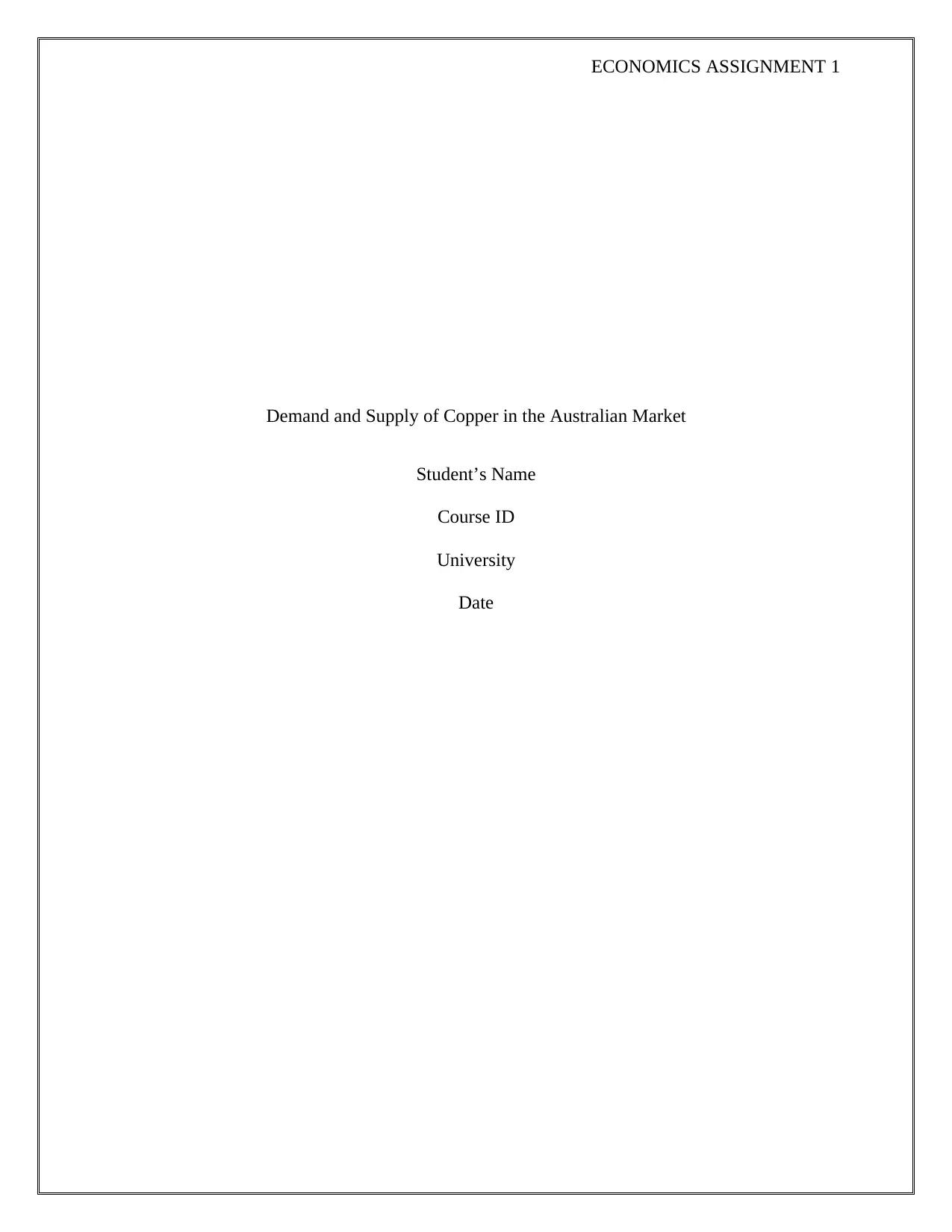
ECONOMICS ASSIGNMENT 1
Demand and Supply of Copper in the Australian Market
Student’s Name
Course ID
University
Date
Demand and Supply of Copper in the Australian Market
Student’s Name
Course ID
University
Date
Paraphrase This Document
Need a fresh take? Get an instant paraphrase of this document with our AI Paraphraser
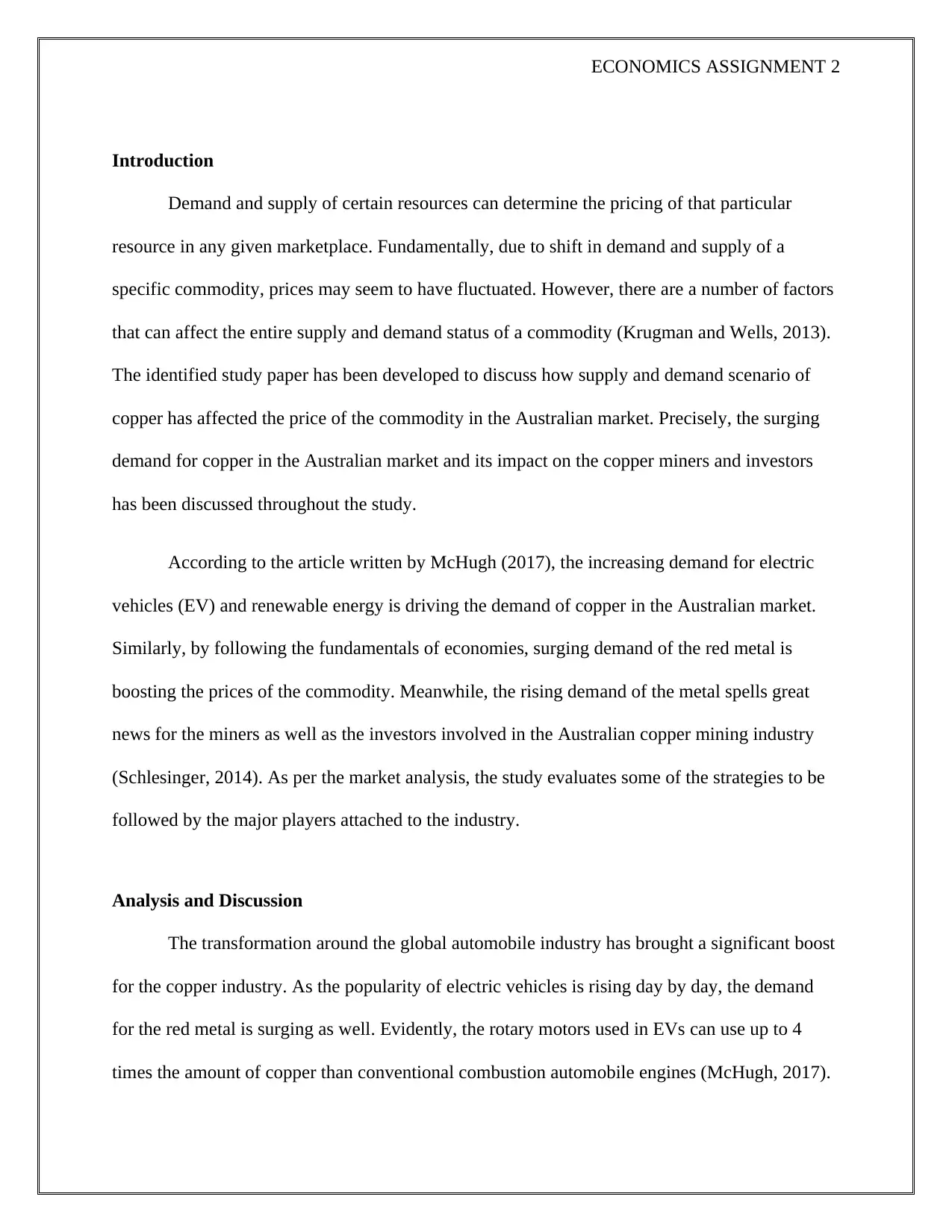
ECONOMICS ASSIGNMENT 2
Introduction
Demand and supply of certain resources can determine the pricing of that particular
resource in any given marketplace. Fundamentally, due to shift in demand and supply of a
specific commodity, prices may seem to have fluctuated. However, there are a number of factors
that can affect the entire supply and demand status of a commodity (Krugman and Wells, 2013).
The identified study paper has been developed to discuss how supply and demand scenario of
copper has affected the price of the commodity in the Australian market. Precisely, the surging
demand for copper in the Australian market and its impact on the copper miners and investors
has been discussed throughout the study.
According to the article written by McHugh (2017), the increasing demand for electric
vehicles (EV) and renewable energy is driving the demand of copper in the Australian market.
Similarly, by following the fundamentals of economies, surging demand of the red metal is
boosting the prices of the commodity. Meanwhile, the rising demand of the metal spells great
news for the miners as well as the investors involved in the Australian copper mining industry
(Schlesinger, 2014). As per the market analysis, the study evaluates some of the strategies to be
followed by the major players attached to the industry.
Analysis and Discussion
The transformation around the global automobile industry has brought a significant boost
for the copper industry. As the popularity of electric vehicles is rising day by day, the demand
for the red metal is surging as well. Evidently, the rotary motors used in EVs can use up to 4
times the amount of copper than conventional combustion automobile engines (McHugh, 2017).
Introduction
Demand and supply of certain resources can determine the pricing of that particular
resource in any given marketplace. Fundamentally, due to shift in demand and supply of a
specific commodity, prices may seem to have fluctuated. However, there are a number of factors
that can affect the entire supply and demand status of a commodity (Krugman and Wells, 2013).
The identified study paper has been developed to discuss how supply and demand scenario of
copper has affected the price of the commodity in the Australian market. Precisely, the surging
demand for copper in the Australian market and its impact on the copper miners and investors
has been discussed throughout the study.
According to the article written by McHugh (2017), the increasing demand for electric
vehicles (EV) and renewable energy is driving the demand of copper in the Australian market.
Similarly, by following the fundamentals of economies, surging demand of the red metal is
boosting the prices of the commodity. Meanwhile, the rising demand of the metal spells great
news for the miners as well as the investors involved in the Australian copper mining industry
(Schlesinger, 2014). As per the market analysis, the study evaluates some of the strategies to be
followed by the major players attached to the industry.
Analysis and Discussion
The transformation around the global automobile industry has brought a significant boost
for the copper industry. As the popularity of electric vehicles is rising day by day, the demand
for the red metal is surging as well. Evidently, the rotary motors used in EVs can use up to 4
times the amount of copper than conventional combustion automobile engines (McHugh, 2017).
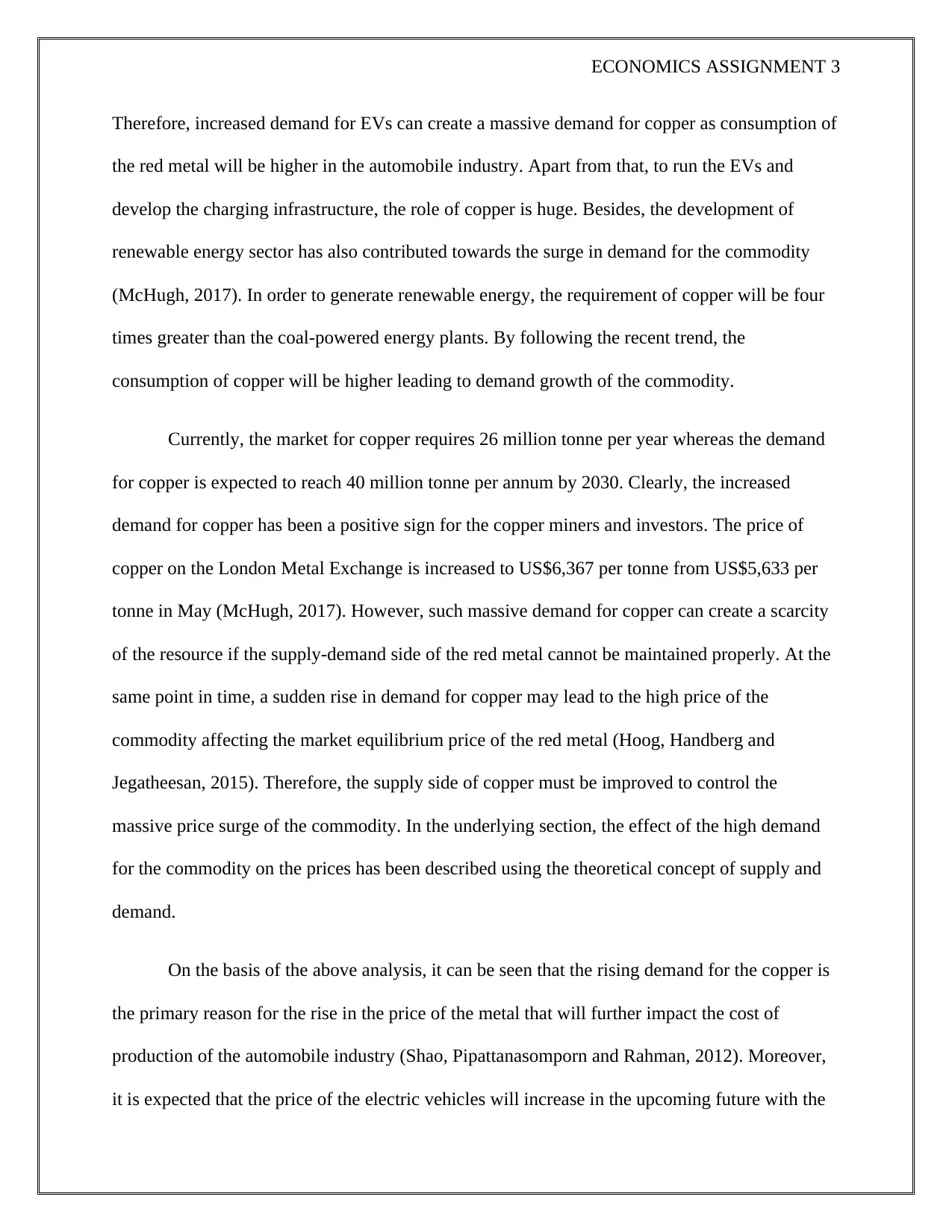
ECONOMICS ASSIGNMENT 3
Therefore, increased demand for EVs can create a massive demand for copper as consumption of
the red metal will be higher in the automobile industry. Apart from that, to run the EVs and
develop the charging infrastructure, the role of copper is huge. Besides, the development of
renewable energy sector has also contributed towards the surge in demand for the commodity
(McHugh, 2017). In order to generate renewable energy, the requirement of copper will be four
times greater than the coal-powered energy plants. By following the recent trend, the
consumption of copper will be higher leading to demand growth of the commodity.
Currently, the market for copper requires 26 million tonne per year whereas the demand
for copper is expected to reach 40 million tonne per annum by 2030. Clearly, the increased
demand for copper has been a positive sign for the copper miners and investors. The price of
copper on the London Metal Exchange is increased to US$6,367 per tonne from US$5,633 per
tonne in May (McHugh, 2017). However, such massive demand for copper can create a scarcity
of the resource if the supply-demand side of the red metal cannot be maintained properly. At the
same point in time, a sudden rise in demand for copper may lead to the high price of the
commodity affecting the market equilibrium price of the red metal (Hoog, Handberg and
Jegatheesan, 2015). Therefore, the supply side of copper must be improved to control the
massive price surge of the commodity. In the underlying section, the effect of the high demand
for the commodity on the prices has been described using the theoretical concept of supply and
demand.
On the basis of the above analysis, it can be seen that the rising demand for the copper is
the primary reason for the rise in the price of the metal that will further impact the cost of
production of the automobile industry (Shao, Pipattanasomporn and Rahman, 2012). Moreover,
it is expected that the price of the electric vehicles will increase in the upcoming future with the
Therefore, increased demand for EVs can create a massive demand for copper as consumption of
the red metal will be higher in the automobile industry. Apart from that, to run the EVs and
develop the charging infrastructure, the role of copper is huge. Besides, the development of
renewable energy sector has also contributed towards the surge in demand for the commodity
(McHugh, 2017). In order to generate renewable energy, the requirement of copper will be four
times greater than the coal-powered energy plants. By following the recent trend, the
consumption of copper will be higher leading to demand growth of the commodity.
Currently, the market for copper requires 26 million tonne per year whereas the demand
for copper is expected to reach 40 million tonne per annum by 2030. Clearly, the increased
demand for copper has been a positive sign for the copper miners and investors. The price of
copper on the London Metal Exchange is increased to US$6,367 per tonne from US$5,633 per
tonne in May (McHugh, 2017). However, such massive demand for copper can create a scarcity
of the resource if the supply-demand side of the red metal cannot be maintained properly. At the
same point in time, a sudden rise in demand for copper may lead to the high price of the
commodity affecting the market equilibrium price of the red metal (Hoog, Handberg and
Jegatheesan, 2015). Therefore, the supply side of copper must be improved to control the
massive price surge of the commodity. In the underlying section, the effect of the high demand
for the commodity on the prices has been described using the theoretical concept of supply and
demand.
On the basis of the above analysis, it can be seen that the rising demand for the copper is
the primary reason for the rise in the price of the metal that will further impact the cost of
production of the automobile industry (Shao, Pipattanasomporn and Rahman, 2012). Moreover,
it is expected that the price of the electric vehicles will increase in the upcoming future with the
⊘ This is a preview!⊘
Do you want full access?
Subscribe today to unlock all pages.

Trusted by 1+ million students worldwide
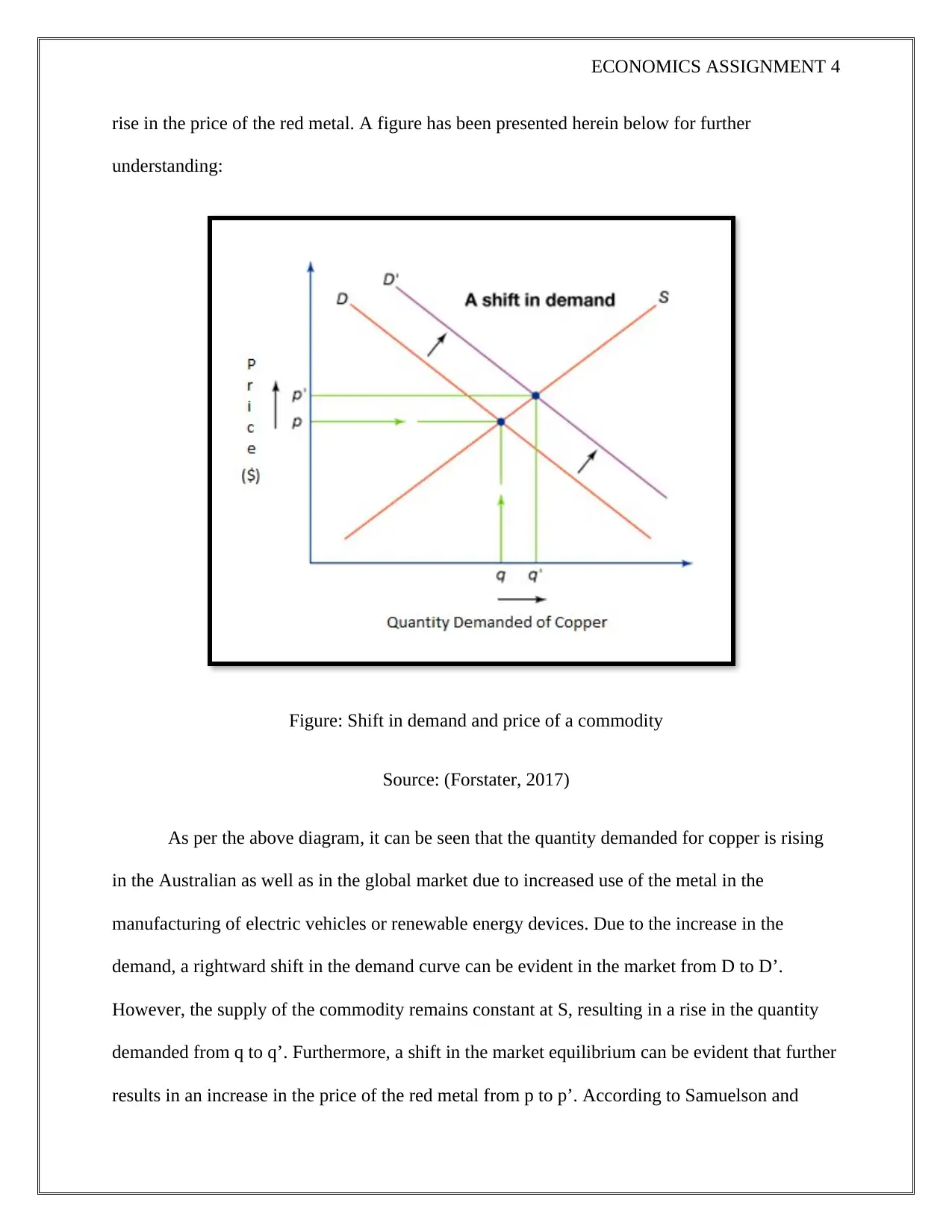
ECONOMICS ASSIGNMENT 4
rise in the price of the red metal. A figure has been presented herein below for further
understanding:
Figure: Shift in demand and price of a commodity
Source: (Forstater, 2017)
As per the above diagram, it can be seen that the quantity demanded for copper is rising
in the Australian as well as in the global market due to increased use of the metal in the
manufacturing of electric vehicles or renewable energy devices. Due to the increase in the
demand, a rightward shift in the demand curve can be evident in the market from D to D’.
However, the supply of the commodity remains constant at S, resulting in a rise in the quantity
demanded from q to q’. Furthermore, a shift in the market equilibrium can be evident that further
results in an increase in the price of the red metal from p to p’. According to Samuelson and
rise in the price of the red metal. A figure has been presented herein below for further
understanding:
Figure: Shift in demand and price of a commodity
Source: (Forstater, 2017)
As per the above diagram, it can be seen that the quantity demanded for copper is rising
in the Australian as well as in the global market due to increased use of the metal in the
manufacturing of electric vehicles or renewable energy devices. Due to the increase in the
demand, a rightward shift in the demand curve can be evident in the market from D to D’.
However, the supply of the commodity remains constant at S, resulting in a rise in the quantity
demanded from q to q’. Furthermore, a shift in the market equilibrium can be evident that further
results in an increase in the price of the red metal from p to p’. According to Samuelson and
Paraphrase This Document
Need a fresh take? Get an instant paraphrase of this document with our AI Paraphraser
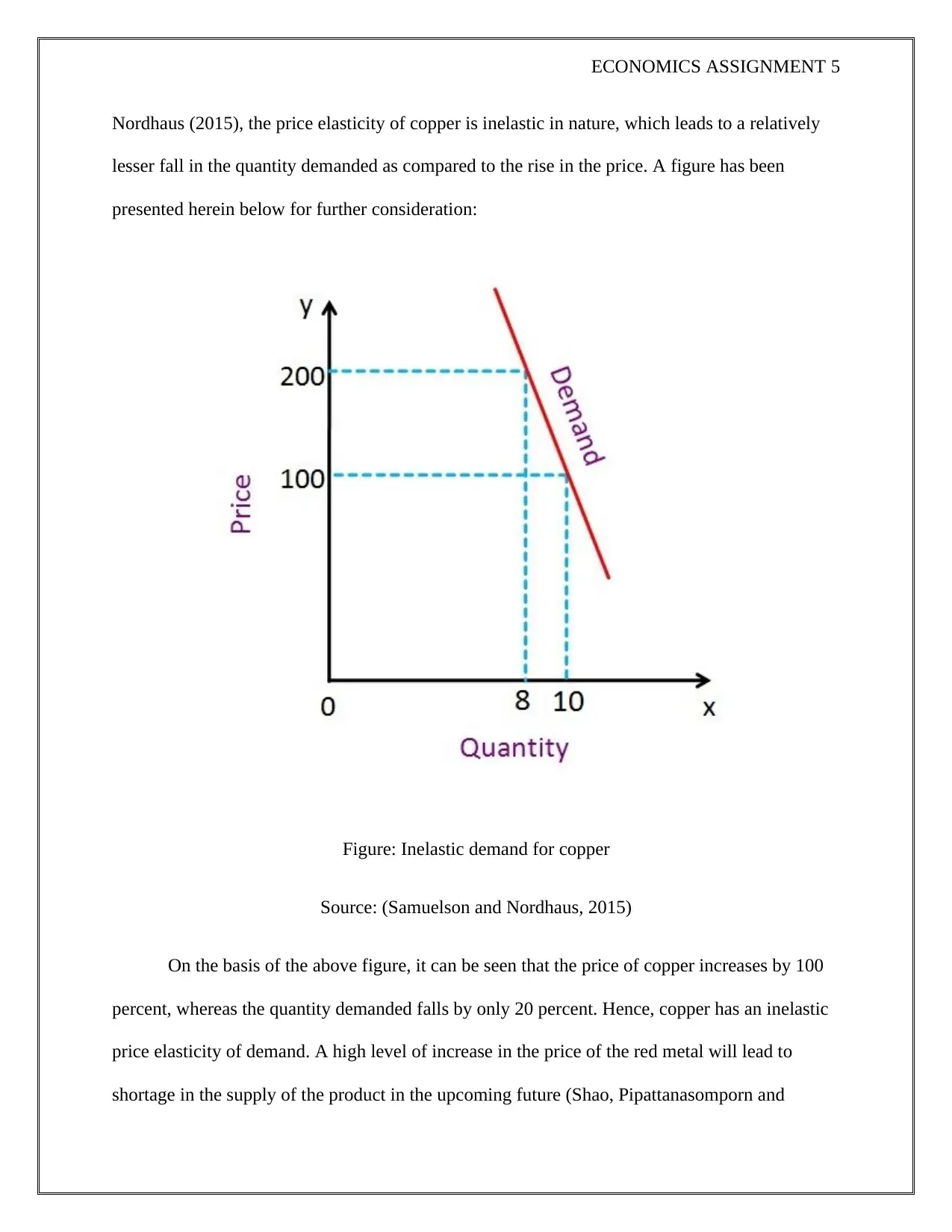
ECONOMICS ASSIGNMENT 5
Nordhaus (2015), the price elasticity of copper is inelastic in nature, which leads to a relatively
lesser fall in the quantity demanded as compared to the rise in the price. A figure has been
presented herein below for further consideration:
Figure: Inelastic demand for copper
Source: (Samuelson and Nordhaus, 2015)
On the basis of the above figure, it can be seen that the price of copper increases by 100
percent, whereas the quantity demanded falls by only 20 percent. Hence, copper has an inelastic
price elasticity of demand. A high level of increase in the price of the red metal will lead to
shortage in the supply of the product in the upcoming future (Shao, Pipattanasomporn and
Nordhaus (2015), the price elasticity of copper is inelastic in nature, which leads to a relatively
lesser fall in the quantity demanded as compared to the rise in the price. A figure has been
presented herein below for further consideration:
Figure: Inelastic demand for copper
Source: (Samuelson and Nordhaus, 2015)
On the basis of the above figure, it can be seen that the price of copper increases by 100
percent, whereas the quantity demanded falls by only 20 percent. Hence, copper has an inelastic
price elasticity of demand. A high level of increase in the price of the red metal will lead to
shortage in the supply of the product in the upcoming future (Shao, Pipattanasomporn and
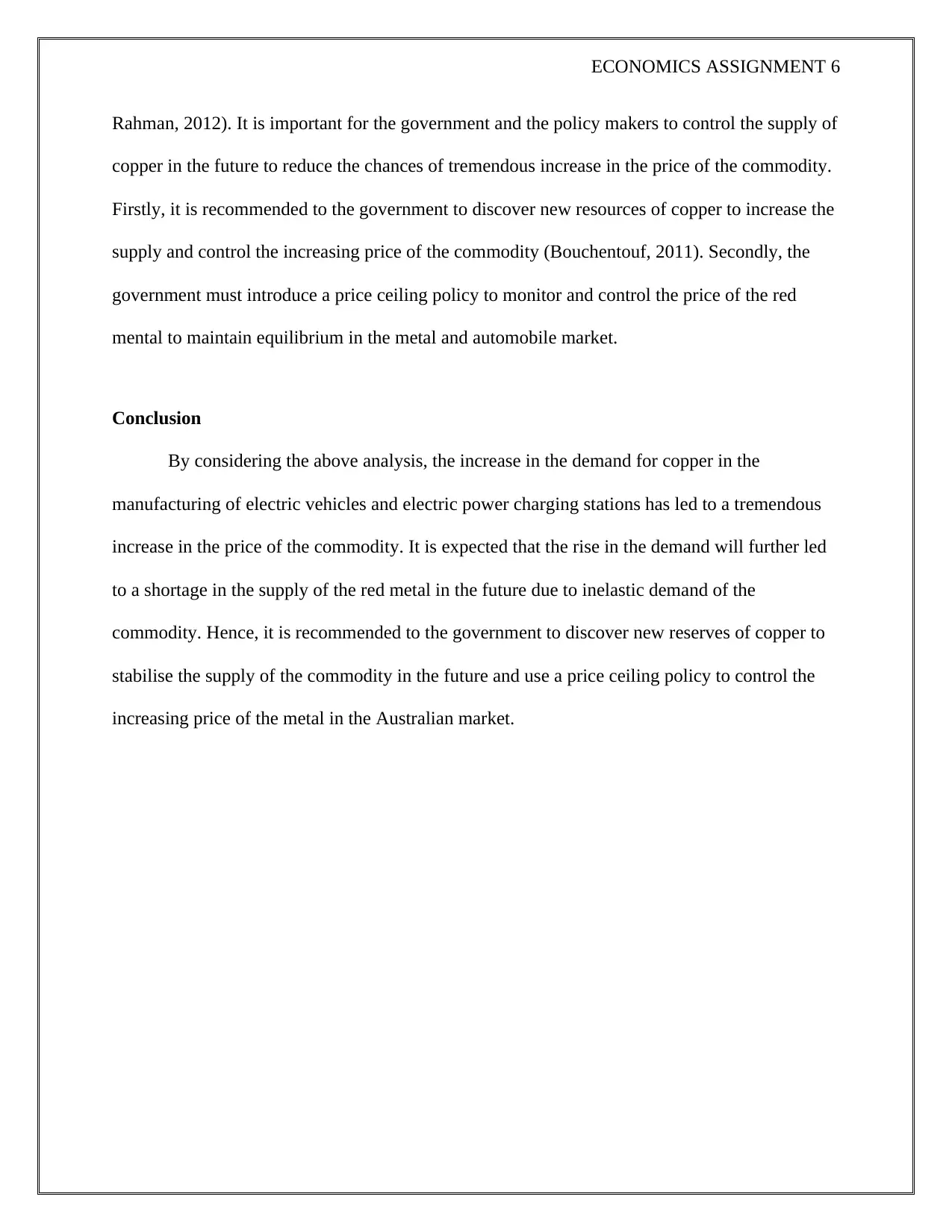
ECONOMICS ASSIGNMENT 6
Rahman, 2012). It is important for the government and the policy makers to control the supply of
copper in the future to reduce the chances of tremendous increase in the price of the commodity.
Firstly, it is recommended to the government to discover new resources of copper to increase the
supply and control the increasing price of the commodity (Bouchentouf, 2011). Secondly, the
government must introduce a price ceiling policy to monitor and control the price of the red
mental to maintain equilibrium in the metal and automobile market.
Conclusion
By considering the above analysis, the increase in the demand for copper in the
manufacturing of electric vehicles and electric power charging stations has led to a tremendous
increase in the price of the commodity. It is expected that the rise in the demand will further led
to a shortage in the supply of the red metal in the future due to inelastic demand of the
commodity. Hence, it is recommended to the government to discover new reserves of copper to
stabilise the supply of the commodity in the future and use a price ceiling policy to control the
increasing price of the metal in the Australian market.
Rahman, 2012). It is important for the government and the policy makers to control the supply of
copper in the future to reduce the chances of tremendous increase in the price of the commodity.
Firstly, it is recommended to the government to discover new resources of copper to increase the
supply and control the increasing price of the commodity (Bouchentouf, 2011). Secondly, the
government must introduce a price ceiling policy to monitor and control the price of the red
mental to maintain equilibrium in the metal and automobile market.
Conclusion
By considering the above analysis, the increase in the demand for copper in the
manufacturing of electric vehicles and electric power charging stations has led to a tremendous
increase in the price of the commodity. It is expected that the rise in the demand will further led
to a shortage in the supply of the red metal in the future due to inelastic demand of the
commodity. Hence, it is recommended to the government to discover new reserves of copper to
stabilise the supply of the commodity in the future and use a price ceiling policy to control the
increasing price of the metal in the Australian market.
⊘ This is a preview!⊘
Do you want full access?
Subscribe today to unlock all pages.

Trusted by 1+ million students worldwide
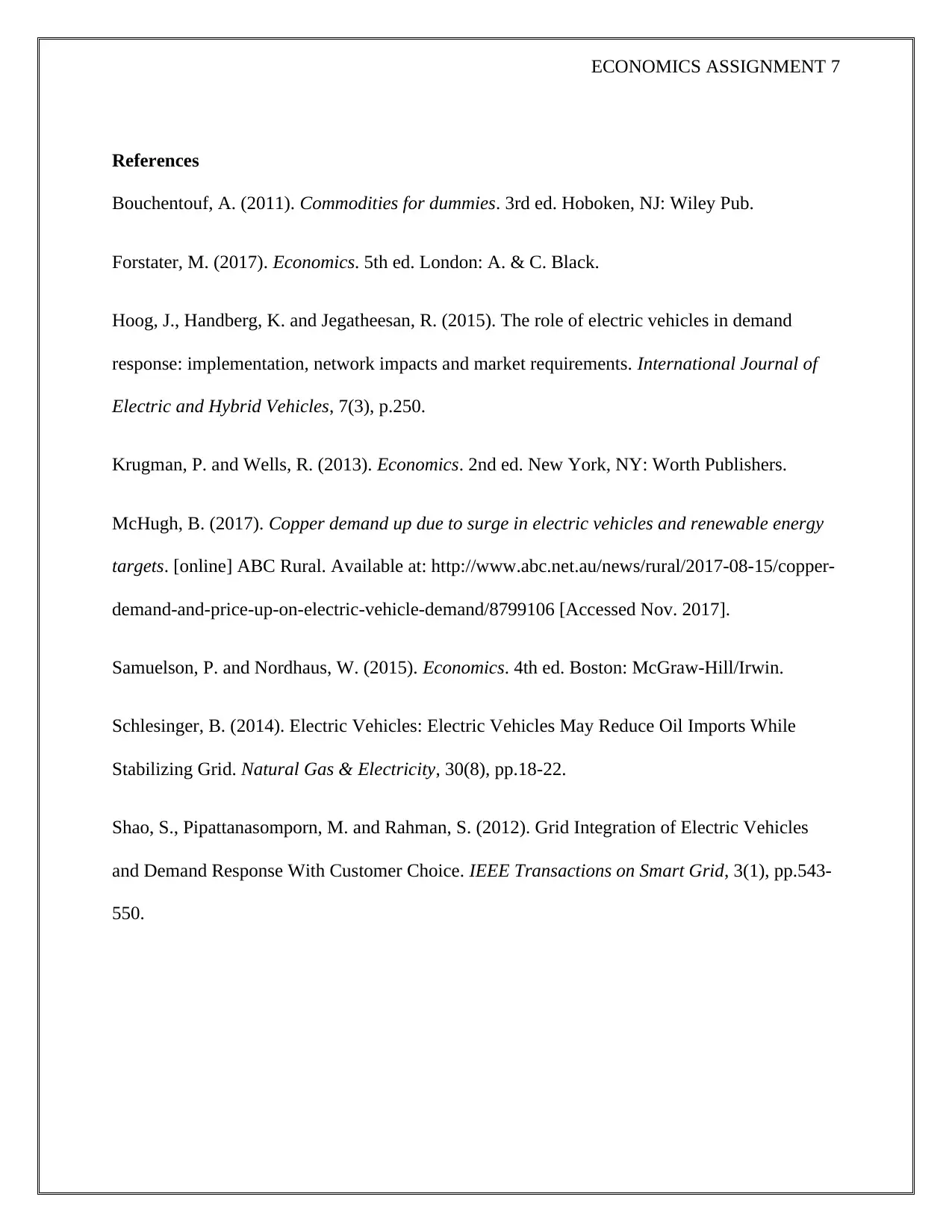
ECONOMICS ASSIGNMENT 7
References
Bouchentouf, A. (2011). Commodities for dummies. 3rd ed. Hoboken, NJ: Wiley Pub.
Forstater, M. (2017). Economics. 5th ed. London: A. & C. Black.
Hoog, J., Handberg, K. and Jegatheesan, R. (2015). The role of electric vehicles in demand
response: implementation, network impacts and market requirements. International Journal of
Electric and Hybrid Vehicles, 7(3), p.250.
Krugman, P. and Wells, R. (2013). Economics. 2nd ed. New York, NY: Worth Publishers.
McHugh, B. (2017). Copper demand up due to surge in electric vehicles and renewable energy
targets. [online] ABC Rural. Available at: http://www.abc.net.au/news/rural/2017-08-15/copper-
demand-and-price-up-on-electric-vehicle-demand/8799106 [Accessed Nov. 2017].
Samuelson, P. and Nordhaus, W. (2015). Economics. 4th ed. Boston: McGraw-Hill/Irwin.
Schlesinger, B. (2014). Electric Vehicles: Electric Vehicles May Reduce Oil Imports While
Stabilizing Grid. Natural Gas & Electricity, 30(8), pp.18-22.
Shao, S., Pipattanasomporn, M. and Rahman, S. (2012). Grid Integration of Electric Vehicles
and Demand Response With Customer Choice. IEEE Transactions on Smart Grid, 3(1), pp.543-
550.
References
Bouchentouf, A. (2011). Commodities for dummies. 3rd ed. Hoboken, NJ: Wiley Pub.
Forstater, M. (2017). Economics. 5th ed. London: A. & C. Black.
Hoog, J., Handberg, K. and Jegatheesan, R. (2015). The role of electric vehicles in demand
response: implementation, network impacts and market requirements. International Journal of
Electric and Hybrid Vehicles, 7(3), p.250.
Krugman, P. and Wells, R. (2013). Economics. 2nd ed. New York, NY: Worth Publishers.
McHugh, B. (2017). Copper demand up due to surge in electric vehicles and renewable energy
targets. [online] ABC Rural. Available at: http://www.abc.net.au/news/rural/2017-08-15/copper-
demand-and-price-up-on-electric-vehicle-demand/8799106 [Accessed Nov. 2017].
Samuelson, P. and Nordhaus, W. (2015). Economics. 4th ed. Boston: McGraw-Hill/Irwin.
Schlesinger, B. (2014). Electric Vehicles: Electric Vehicles May Reduce Oil Imports While
Stabilizing Grid. Natural Gas & Electricity, 30(8), pp.18-22.
Shao, S., Pipattanasomporn, M. and Rahman, S. (2012). Grid Integration of Electric Vehicles
and Demand Response With Customer Choice. IEEE Transactions on Smart Grid, 3(1), pp.543-
550.
1 out of 7
Related Documents
Your All-in-One AI-Powered Toolkit for Academic Success.
+13062052269
info@desklib.com
Available 24*7 on WhatsApp / Email
![[object Object]](/_next/static/media/star-bottom.7253800d.svg)
Unlock your academic potential
Copyright © 2020–2025 A2Z Services. All Rights Reserved. Developed and managed by ZUCOL.





